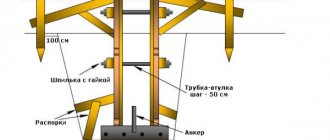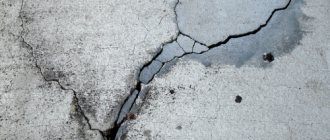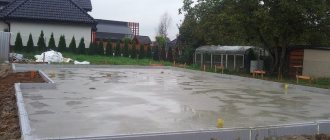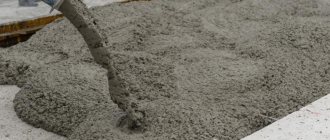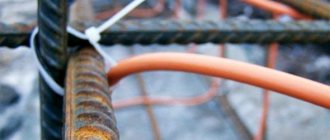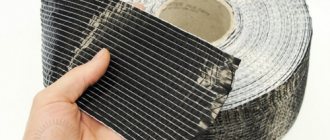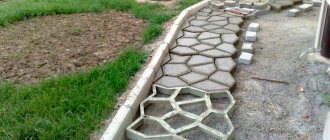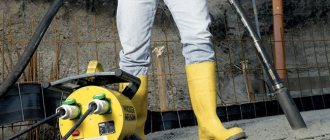Compaction of concrete is the most important stage in the technological process of pouring concrete structures. It is necessary to ensure the specified physical and mechanical characteristics of the concrete mixture. After all, the voids formed during the pouring of the solution due to the air contained in it, as well as uneven filling of the form or formwork, will inevitably lead to the destruction of structures over time.
Compaction of the concrete mixture due to the uniform distribution of the incoming components makes it possible to increase the strength and water resistance of concrete and increase its volumetric weight by 10%.
Compaction methods
Builders use the following types of devices when compacting the mixture:
- surface (for the top layer of cement);
- deep (large concrete structures);
- external (installed before compaction at the edge of wooden formwork or a container with cement mortar);
- vibration platforms (used at specialized enterprises).
There are different methods to compact cement mortar:
1). Manually . It is practiced mainly in private construction work, as this method helps to save money on the purchase of equipment. Manual compaction is used in cases where it is necessary to process the mixture in small quantities. As a rule, in such cases the solution is also made by hand. The concrete surface is processed with a crowbar, tamper, shovel, etc.
Baying the foundation after pouring concrete.
2). Bayoneting. To perform this procedure, a metal rod (for example, a reinforced rod) weighing up to four kilograms is used. In this case, it is desirable that the tip of the rod be rounded. It is used to “pierce” concrete. Experts recommend piercing the entire surface of the container with the mixture. This method allows you to compact crushed stone, displace air and excess liquid.
3). Manual tamping. This method is usually used for compacting heavy concrete mortars. For unreinforced structures, builders use manual or mechanical tampers. Compaction should be done carefully and layer by layer. However, the thickness of the compacted layer should be no more than fifteen centimeters.
Types of vibration platforms
Any vibrating platform includes two frames. A container with concrete mortar is mounted on the upper movable one. The lower one is motionless and is attached to the base. The upper frame, together with the vibration mechanism located on it, is supported on a stationary frame using shock absorbers - springs, springs, rubber gaskets.
Typically, the vibration mechanism is made in the form of shafts with unbalances, which begin to rotate due to the operation of an electric motor. The upper frame (which is movable) must be sufficiently rigid, otherwise uneven amplitude of vibrations may occur. Where the vibrations are weak, the compaction of the solution will be insufficient.
Other methods
Other compaction methods include:
1) . Mechanical . Builders resort to this method when processing significant volumes of cement. The process is carried out using special devices, which include surface and internal vibration devices. Specialists also use mechanisms that are attached to wooden formwork or a container with a mixture.
In particular, surface vibratory slats allow only the top concrete layer to be compacted. Therefore, builders use it for products made from a thin layer of concrete: bases for tiles, floors, roads, etc. The internal vibrating screed, in turn, is considered the most effective in comparison with other mechanisms. In addition, such devices are easy to operate and are used for processing concrete in hard-to-reach areas.
Vibrators, which are installed on wooden formwork or form, are securely fastened, compacting the mixture due to vibrations of the formwork transmitted to the cement mortar. Formwork devices are indispensable for concreting products of unusual shapes.
2). Vibration compaction. Produced using portable and stationary devices. The use of portable mechanisms for precast concrete structures is limited. They are used to create large and heavy products.
Vibrating platforms are necessary in the production of reinforced concrete in factories operating according to special schemes. The modern market offers a large selection of vibrating platforms, including electromagnetic, pneumatic, combined, etc.
3). Pressing. Experts less often resort to this method of compacting the mixture, although it is considered effective because it allows increasing the strength of the mortar with low cement consumption. This method is not widely used due to its high cost.
The pressure required for pressing concrete should be from 10 MPa. Presses that have similar power are used in the shipbuilding industry to create new ships. However, it should be noted that the cost of such pressing devices does not allow them to be used for private construction work.
During the preparation of cement mortars, pressing should be used only as an additional load during vibration compaction. The required degree of pressure can be no higher than 1 kPa. The modern market offers flat and profile dies. In particular, profile stamps are needed to give the desired texture to a particular product.
This is how concrete panels, flights of stairs and other elements and structures from this material are made. This type of pressing is called stamping. Another type of pressing is rolling. In this case, the pressure on the cement mortar is carried out by the roller. This allows you to reduce energy consumption due to reduced pressure during pressing.
But the method has one drawback related to the properties of the solution. In some cases, the material may be displaced or torn by the roller.
4). Centrifugation. When rotating, the composition is compacted by adhering to the walls of the mold. After centrifugation, the density of the ingredients included in the cement mortar increases. In addition, approximately 30 percent of the water is removed from it. This helps increase the strength of concrete. The method allows you to make durable products.
Centrifugation will require more cement than other types of compaction. The concrete solution will have the required viscosity. Otherwise, under the influence of the centrifuge, the composition will separate. The technology helps make power line supports, racks and pipes.
5). Vacuuming. The method allows you to rarefy the air, so that all excess is removed from the mixture under strong pressure. Accordingly, the density of the mixture increases.
Recommendations
To ensure that the cement composition is evenly compacted, the following recommendations must be followed:
- When installing wooden formwork, you should pay attention to the reliable fixation of parts. There should be no gaps on the structural elements (the concrete solution can be squeezed out through the cracks). It is necessary that the formwork is polished and smooth, otherwise it will leave dents on the product. In addition, voids may subsequently form in the body of the structure.
- Parts of wooden or plywood formwork, including wedges, must be securely fixed to prevent the boards from moving.
- When vibrating the composition, you should periodically change the position of the vibrating screed, otherwise the solution will be inhomogeneous and cavities will form.
- Experts advise not to spend a lot of time on the work, as this can cause delamination, which appears due to the fact that large crushed stone is knocked down at the bottom, and only cement mortar accumulates at the top.
Defects in concrete and reinforced concrete structures due to insufficient compaction of the concrete mixture.
Since the use of surface vibrating devices does not allow visual determination of the degree of density, during construction work an additional means is often used to help ensure the strength of the composition. To do this, builders add a solution with high plasticity to the existing composition. For this reason, the risk of product delamination increases. To avoid such a drawback, it is recommended to increase the amount of cement.
Compaction factor
The quality of a concrete composition can be assessed using one important criterion. We are talking about the compaction coefficient. The coefficient is determined as follows: the ratio of the specific gravity of the finished mixture to the value that was obtained in the absence of air bubbles inside is calculated. Thus, the acceptable value of the coefficient is 1.
This indicator can be achieved using different methods of concrete compaction; the choice of methods will depend directly on the composition, purpose and fractions. Automated vibrating screeds significantly increase the quality of the solution.
What is the shrinkage coefficient of concrete and how to increase it
- Date: 11-04-2018
- Comments:
- Rating: 49
Currently, there is no ideal building material. Any, even the most modern building material has its advantages and disadvantages. Concrete is widely used in construction. It has high strength, resistance to mechanical and chemical influences, and a long service life. There is such a thing as concrete shrinkage coefficient. Despite its high strength, concrete can change its dimensions immediately after hardening. All this can negatively affect the appearance of the structure. An interesting fact is that this figure increases over time.
Shrinkage of concrete is a phenomenon in which the poured mass changes its size and configuration during the setting process.
Some people believe that concrete shrinkage depends only on external factors. This is not entirely true. It must be remembered that sedimentation is a natural process. At the same time, the main task of builders when pouring concrete is to make it better by adding various additives and thereby reducing the shrinkage rate. Let us consider in more detail the significance of this indicator in construction, the amount of concrete shrinkage under normal conditions.
What is precipitation
Even the best quality concrete is prone to settling. It is impossible to completely avoid this phenomenon. Concrete shrinkage is a phenomenon in which the poured mass changes its size and configuration during the setting process. During this process, the concrete is compacted and hardened. It is of great importance that the intensity and magnitude can be influenced by factors of physical and chemical nature.
Setting of concrete.
Setting of concrete, depending on its brand and the presence of special additives, occurs within several tens of minutes or hours. Why is it necessary to determine the possible amount of concrete shrinkage during construction work?
The answer is quite simple. This is necessary in order to correctly calculate the thickness of the concrete. The latter is used mainly for pouring foundations, building roads, and concrete paths. In all cases, the poured surface must have a certain thickness and shape. The strength and durability of the structure depends on this. Due to all this, calculating the sedimentation coefficient is necessary in order to correctly pour concrete. In this case, it should be with a reserve. The calculated and actual thickness and shape of concrete must match. Otherwise, the excess concrete will not be easy to remove, and the deficiency will be difficult to fill.
Return to contents
The sedimentation coefficient is a value that is indicated in construction regulations. The coefficient under consideration largely depends on the quality of preparation of the concrete mixture. Shrinkage of concrete, depending on time parameters, is of the following types:
- plastic;
- young concrete;
- mature concrete.
Plastic shrinkage of concrete.
In the first case, shrinkage is observed even before complete hardening. In the construction industry there is such a thing as the design age of concrete. This value is 28 days and indicates its complete hardening and suitability for further construction work. Shrinkage of young (hardening) concrete appears before this period. In addition, changes in the size of the material may appear at a later date (later than 28 days).
Classification depending on the etiological factor is of no small importance. In this situation, contraction and humidity are distinguished. As for plastic shrinkage, it is included in the concept of moisture shrinkage. The contraction type is also called concrete compression. The main reason for this phenomenon is the chemical interaction of the components (water and minerals). It is important that such shrinkage leads to an increase in the number of pores in the material, which reduces its performance characteristics.
The humidity type has its own distinctive features. It develops during the drying process of the concrete mixture. As a result of all this, the amount of water in concrete decreases sharply and it shrinks. It is more important than the previous one. At the very early stage of moisture reduction, plastic shrinkage can be observed. In most cases, it is observed in the first half hour from the moment the concrete is poured. It is important that the value of the shrinkage coefficient is influenced by the presence or absence of reinforcement and the amount of water in liquid concrete.
Return to contents
The coefficient is an indicator that reflects the change in volume relative to the original during the filling process.
Shrinkage of young concrete.
It is measured as a percentage. A ratio of less than 1.5% is considered optimal. In all other cases, a similar coefficient indicates significant changes in the structure of concrete. In some cases, a high shrinkage coefficient is a risk factor for the appearance of cracks and other defects in the poured building material. It must be remembered that the coefficient also depends on the brand of concrete mixture. The higher the latter, the lower the coefficient will be.
The average value of the coefficient today ranges from 0.97 to 1. Such figures are quite difficult to achieve for a non-professional who does not have much experience in preparing concrete mortar. A high ratio may be a result of improper vibration of the mixture. Often the coefficient increases so much that subsequently it is necessary to increase concrete in the place of shrinkage. All this is fraught with a decrease in its load-bearing capacity and damage. In addition, the extension process takes a significant amount of time, which is very important when constructing buildings and structures.
Return to contents
The absolute value of concrete shrinkage.
The shrinkage coefficient allows you to estimate possible losses. Along with it, builders need to know exact figures in terms of the thickness of the poured concrete. Under normal conditions, the shrinkage value of the concrete mixture is about 0.2-0.4 mm/m. At first glance, the indicators are very insignificant. But if you take into account the area of the poured mixture and its total thickness (often it reaches several meters), then the value will be noticeable. For liquid cement, the numbers will be completely different. Under normal conditions, when cement hardens, shrinkage is 3-5 mm/m.
During the construction of a building, workers must draw up an estimate. It includes various calculations, including the calculation of the shrinkage coefficient. We must not forget that even when the mixture is completely hardened, shrinkage occurs. During the operation of structures, the material is influenced by atmospheric air (carbon dioxide) and precipitation. A sharp change in temperature is of great importance. The coefficient increases more often at negative temperatures. In this case, the length of the poured concrete may change. The absolute values of shrinkage can reach several centimeters.
Return to contents
Coefficient of change in concrete volume.
The coefficient of change in the volume of poured material may increase due to several reasons. Firstly, the main predisposing factor is poor-quality preparation of the concrete mixture. This takes into account the proportion of cement powder, crushed stone (gravel), sand and water. Secondly, the brand of prepared concrete is of great importance. Thirdly, another factor affecting the coating during its hardening is surface moisture. It has been established that the optimal humidity value is 55-70%. If the humidity is low, the coefficient will be higher, and the material will gradually begin to compress.
Fourthly, there is a certain relationship between the density (heaviness) of the mixture and the shrinkage coefficient. The lower the mass of the concrete solution, the higher the coefficient. Fifthly, shrinkage is more pronounced in those structures where there is no reinforcement, that is, there is no rigid frame inside the concrete solution. Experienced developers know that one of the stages of preparing a concrete mixture is processing it with a special vibrating installation. It is necessary in order to remove excess air from the solution. In its absence, the porosity of the material increases and its strength decreases, which results in shrinkage.
Return to contents
To avoid obtaining low-quality concrete and a high shrinkage rate, several important rules must be followed:
Change in the coefficient of transverse deformation of concrete during eccentric compression testing.
- do not use low grade concrete for the construction of residential buildings;
- use a metal frame to strengthen concrete;
- knead under optimal conditions;
- maintain proportions when preparing the working solution;
- process the mixture with a vibrator;
- provide the necessary moisture to the surface of the material.
Particular attention must be paid to specially added additives. If we evaluate the importance of all components of concrete, then water and fillers play the greatest role in obtaining the desired shrinkage coefficient. Often, when carrying out complex and voluminous construction work, concrete based on special additives is used. Otherwise, such mixtures are called with compensated shrinkage. Additives added to the solution contribute to its expansion, as a result of which the coefficient under consideration is reduced and the risk of cracking is reduced.
https://youtu.be/Hpj_7mrrwEU
Return to contents
Thus, shrinkage of concrete is almost always observed. The only difference is in the degree of its severity. In some cases (under normal conditions) it is several millimeters, and in others – centimeters. All this not only worsens the appearance of the coating, but also requires repair work (pouring a new layer of mortar). In the latter case, it is not possible to obtain a homogeneous mixture, since the bottom layer is much denser and stronger than the newly poured one.
https://youtu.be/Ln–yopJzuY
The builder’s task is to prevent a sharp increase in the mixture settlement coefficient. It is important that this value is not always indicated and calculated during construction. This is done to a greater extent when large volumes of concrete have to be poured or high-quality coating is required. In many ways, obtaining a high-quality mixture depends on the worker himself. If you follow all the above rules, the shrinkage of the solution will be insignificant, cracks will not form, and the coating will last for many years.
ostroymaterialah.ru
What does the coefficient depend on?
This indicator is determined by the grain size of the composition, as well as the object that will be concreted, be it blind areas, routes, paths.
conclusions
Experienced builders claim that the stability and durability of the structure will depend on the density of the concrete solution. This must be taken into account if you want the product to serve you for more than one year. Timely measures will help to further increase the protection of the structure from damage and save money on restoration work.
Universal vibration devices will produce high-quality concrete. Before carrying out construction work, you need to consult with specialists in advance and select the necessary equipment. Ergonomic vibrating devices allow construction workers to compact cement in a wide range of conditions.
To perform a small amount of construction work, professionals recommend using a portable vibrator weighing up to five kilograms. For larger-scale work, builders use large tools that allow them to effectively compact concrete in production with a large front of concrete work.
Overview of equipment for compacting concrete mixtures
In the process of laying the concrete mixture, it is necessary not only to maintain the correct proportion of sand, cement and water, but also to ensure that no voids appear in the cement mass. If, after pouring the solution, air pockets form in it, this will lead to a decrease in the density of the composition. In turn, this will cause cracking and destruction of the entire structure. To prevent this from happening, it is necessary to use a concrete compactor.
As a rule, compaction is performed using specialized equipment or through simple manipulations.
Methods for compacting concrete
Laying and compacting the concrete mixture can be done in several ways:
Pressing
This method is considered one of the most effective, but builders rarely resort to it due to the high cost of the equipment. The fact is that the presses used for compaction must have a pressure of at least 10 MPa. Equipment of this power is used in shipbuilding, so it’s easy to guess how much it will cost.
Centrifugation
In this case, the concrete mixture is compacted in a centrifuge. During its rotation, the solution is forcefully pressed against the walls of the equipment, and water (more than 30%) and excess air are effectively “squeezed out” from the composition.
Healthy! If you use centrifugation technology, then the cement consumption must be significantly increased.
Vacuuming
The compaction of the mass occurs due to rarefaction of the air. Under extreme pressure, all excess is removed from the laid solution, and the density of the composition increases significantly. However, not everyone can afford such equipment.
Manually
This method of concrete compaction is suitable for processing a small amount of mixture for the construction of your own country house, cabin or bathhouse. When processing concrete mass manually, absolutely everything is done with your own hands. First, a solution is prepared, which is mixed not in a concrete mixer, but in an ordinary trough. After this, using a manual tamper, bayonet and other devices, the concrete solution poured into the formwork is “pierced” over the entire area in increments of 5-10 cm. Thanks to this, all excess air and moisture is removed from the mass.
This also includes manual tamping, which involves the use of homemade or ready-made, simple mechanical devices for compacting heavy concrete mortar.
These are the simplest and cheapest ways to compact concrete yourself.
If it is not possible to work manually or the area of the object is too large, it is worth considering other methods of compacting the concrete mixture. The simplest and most inexpensive of them is the mechanical compaction method, which involves the use of vibration-type equipment.
Mechanical seal
For large volumes of concrete mixture, it is recommended to use specialized equipment.
Surface vibrator
Compaction of concrete mixture with surface-type vibrators is most often used for large areas and a small layer of building mixture. Thanks to this equipment, compaction is performed:
- slab bases;
- floors;
- retaining walls;
- dams;
- road surfaces.
A device of this type also consists of a plate, which is connected to a vibration mechanism. Surface equipment creates vibrations that travel 20-30 cm deep into the solution. This is more than enough to treat a surface of small thickness.
If the height of the concrete base is much greater, then it is recommended to use the vibrating plate after processing with an internal vibrator.
Internal vibrator
A deep vibrator allows you to compact the concrete mixture in a more efficient way, due to the fact that in this case the vibration energy is transferred directly into the concrete composition.
These vibrating concrete compactors are easy to operate and can be used in hard-to-reach areas without any problems.
To use this device:
- Place it in a vertical position.
- Move the vibrator to another part of the surface in increments of 45-75 cm.
- Immerse the device at a speed of no more than 2-3 cm/s.
Important! A deep vibrator cannot be used to distribute the solution over the formwork, otherwise concrete delamination will occur.
Another advantage of the internal vibrator is that it can be used not only for compaction, but also for leveling the surface.
It is worth paying attention to one feature of using such equipment - during the compaction process, air bubbles are formed in the upper layer of the solution. In order to get rid of them, it is necessary to modify the top layer of the surface manually or using a deep vibrator.
Healthy! All vibrators are pneumatic or electric. The first type is considered easier to manage and safer. However, pneumatic equipment may not withstand low temperatures in winter.
To select the highest quality and inexpensive equipment for vibratory compaction of concrete, you should pay attention to the brand and manufacturer of the device.
Vibration compaction of concrete
As can be seen from Fig. 1, the shock mode is significantly longer in time compared to the standard and especially the shock-vibration mode, which is associated with the physical characteristics of the compaction processes. Large particles, due to the low value of the “upper” acceleration (in the upper position of the platform), cannot change their position, do not have the opportunity to loosen and ensure re-arrangement, which reduces the speed of the process.
Currently, in the technology of manufacturing prefabricated and monolithic reinforced concrete, surfactants (surfactants) - plasticizing additives - are widely used. Such superplasticizing additives of type C-3 can significantly increase workability from 2...3 cm of cone settlement to 18...20 cm. In technology, this circumstance is used to ensure increased workability of the mixture, reduce vibration intensity or reduce cement consumption with the same workability. Obviously, we should expect a change in workability in precast reinforced concrete technology from 1...3 cm of cone settlement to 8...12 cm. When using low-frequency modes, delamination can decrease by at least 1.5 times.
Let us evaluate the process of vibration compaction of concrete using methods of similarity theory.
The laying process is influenced by the following parameters of the vibration mode and properties of the concrete mixture: NV - power of transmitted vibration effect FL/t; A is the amplitude of oscillations L; ω is the angular frequency of oscillations 1/t; t—vibration time t; ρ is the density of laying the concrete mixture during vibration compaction Ft2/L4; τ0 is the shear strength of the concrete mixture F/l2; v is the viscosity of the concrete mixture Ft/L2; β is the linear damping coefficient of oscillations 1/l; 1 - reduced size of the compaction zone L; g is the acceleration due to gravity L/t2.
The determining parameters for the mechanical laying process are: force F, time t, length l. The number of dimensionless vibrations, according to the π-theorem (in this problem 10-3=7). When compiling dimensionless combinations, known physical and empirical dependencies are taken into account. For example, vibration compaction is influenced by various combinations of amplitude and frequency: Aω, Aω2, A2ω2, A2ω3, which makes it easier to obtain dimensionless combinations in the following form:
(ρl3А2ω2)/Nb; (ρА2ω2)/τ0; (ρАω)/βv;
NВt/τ0l3; NВt2/vl3; Аω2/g; Aβ.
In its most general form, the density of concrete is expressed
ρ((A2ω3l3)/Nb; A2ω2/τ0; Aω/βv)=f(NВt/τ0l3; NВt2/vl3; Аω2/g; Aβ).
From the above dependence, several qualitative conclusions can be drawn:
- the process of vibration compaction functionally depends on the acceleration of vibrations Аω2, its duration is related to the specific power and properties of the concrete mixture;
- the use of vibration influences with large amplitudes has a positive effect on compaction;
- with increased rigidity of the concrete mixture (large values of τ0 and v), Aω, A2ω2 should be increased.
In connection with the development of a new direction for using low-frequency vibration to compact concrete mixtures, the authors took into account the existing one and formulated a more general hypothesis of vibration compaction. The above formula shows that the process over time is determined by the specific power of vibration action (N/l3) and the properties of the concrete mixture τ0 and v in the following form:
Nt/τ0l3=const=C1; Nt2/vl3=const=C2
Thus, the complex process of vibration compaction of concrete is characterized by the need to overcome the forces of friction, adhesion and viscous resistance. In this case, the final state of the concrete mixture depends, firstly, on the convergence of large and small particles of aggregates, which is characterized by overcoming the mutual forces of friction and adhesion between the particles. Secondly, compaction is a redistribution of cement paste associated with its thixotropic liquefaction. Of course, these aspects of the same process should be considered as a whole. The forces of plastic and viscous resistance jointly prevent the compaction process, but their physical essence is different. Viscous resistance forces reduce the influence of dry friction forces - the cement paste acts as a lubricant in compaction processes. This circumstance predetermined the study by a number of researchers of viscous resistance forces and the reduction of their significance under vibration influence.
The above expression shows that the nature of the vibration compaction process is determined by the constants C1 and C2. In this case, with the same properties of the mixture, compaction will proceed differently: with large amplitudes of vibration, large relative movements of particles occur and the forces of friction - plastic resistance at significant frequencies, due to greater thixotropic liquefaction of the cement paste - viscous resistance forces are overcome more intensively. When exposed to low-frequency modes, a less intense liquefaction of the solution component occurs. On the other hand, large amplitudes contribute to the fastest mutual movement of particles and the overall compaction process will be shorter.
Compaction functionally depends on acceleration, which is accepted as one of the main factors determining this process, which is important for the engineering industry. The lower the acceleration value in the region of rational frequencies and amplitudes will allow you to obtain the highest compaction effect, the more optimal the vibration system.
In connection with the stated physical features of the process of vibration compaction of concrete, the development of the following main directions of vibration technology seems to be possible:
- the use of symmetrical and asymmetrical low-frequency modes (frequency below 30 Hz) as the most universal, allowing for compaction of both rigid and very mobile concrete mixtures;
- introduction of controlled oscillation modes at different oscillation frequencies, direction of the resulting spatial oscillations, load and other modes.
Vibration compactors overview
Builders most often prefer the following models:
Sturm CV7120
This vibrator is durable and highly reliable. Although the portable unit is manufactured in China, it is sold under the brand of a German company that has proven itself well in our market.
The deep vibrator Sturm CV7120 is equipped with a flexible shaft, so it is convenient to use when compacting concrete for reinforced concrete walls, basements and columns.
Unit power 2000 W, vibration frequency 18,000 vibrations/min. At the same time, the equipment weighs a little more than 5 kg.
Advice! If your choice fell on this particular model, then it is better to immediately buy a spare shaft with a mace, since it will be difficult to find them from other suppliers.
The cost of Sturm CV7120 is from 14,000 rubles.
Hervisa Runner Plus 52
Another compact compactor for concrete belongs to the category of professional deep-water equipment. These units are produced by a Spanish manufacturer of the same name, which has been manufacturing vibration equipment for more than 30 years.
The main advantage of Hervisa is the presence of a voltage converter and reliable protection against power surges and overheating. At the same time, a vibrator weighing about 17 kg is capable of processing up to 40 m 3 in just 1 hour. In addition, the unit is equipped with a reliable drive and a flexible shaft.
The power of the equipment is 1500 W at a vibration frequency of 12,000 vibrations/min. The unit costs about 109,000 rubles.
Red Mayak IV-98E
Those who prefer equipment from Russian manufacturers should purchase the Krasny Mayak IV-98E site model. This unit can be mounted both on the formwork and on the slab to create a surface vibrator.
The Red Lighthouse weighs 22.5 kg, but it is compact in size. The engine, shaft and unbalances of the unit are protected by a durable metal casing.
Red Mayak can be used not only for compacting solutions, but also for the manufacture of vibrating tables and other equipment.
The vibrator has a rather low power of 900 W at a vibration frequency of 3000 vibrations/min. The unit costs about 10,500 rubles.
Models such as Wacker Neuson AR 36/3/230 costing about 20,000 rubles, Caliber VER 1500 (from 3,000 rubles), Makita BVR450Z (13,500 rubles) and Grost VGB 4000 W (from 17,000 rubles) can also boast positive reviews. .
Before using the equipment, it is necessary to take into account the difference in the volume of the mixture before and after compaction.
Compaction factor
Before you start using vibration equipment, you need to take into account a very important parameter - the compaction coefficient of the concrete mixture. The fact is that after removing air and excess moisture from the concrete solution, its thickness decreases.
Ready-made mixtures produced in factories have a coefficient of efficiency of 1.02, that is, the volume of concrete mass decreases by 2%. These requirements fully comply with SNiP.
If we talk about the compaction of asphalt concrete, its coefficient will be slightly higher. It is worth considering that everything depends on the consistency of the mixture, its grain size and the construction site itself. As a rule, increased heat loss occurs when paving:
- sidewalk paths;
- blind area for buildings;
- freeways
Also in SNiP there is the concept of averaged coefficient, which is 1.05 (about 5%). Based on these data, it will not be difficult to calculate the volume of concrete you will need for the job.
The use of compaction equipment will improve the characteristics of the concrete mixture. If you do not have the opportunity to purchase a vibration installation, use the manual compaction method.
Shrinkage joints in monolith
When pouring a monolithic slab or tape, it is necessary to make shrinkage joints. Small gaps cut into the body of the slab allow creating conditions for uniform shrinkage, without breaking the monolith. Break lines are drawn according to rules confirmed by calculation of concrete shrinkage.
The screed map is made up of squares or rectangles with an aspect ratio of 1:1.5. The lines must be without bends. The cutting distance is selected based on permissible temperature changes.
Indoors, seams are created every 6 meters, in an open area no more than 3 * 3 m. For paths, a distance of 3.6 m is sufficient. The seam does not cut through the entire thickness of the monolith, it is 1/3 or 1/4 of the thickness of the screed.
If the monolith represents a strong foundation, then drilling with a drill with a diamond attachment is used, which does not destroy the walls and cuts through the concrete like a knife through butter.
Compacting concrete
The technology for erecting concrete structures involves preparing a concrete mixture and compacting it. There are cases when, when mixing a solution, cavities appear inside, which can disrupt the structure and reduce its density. Because of this, cracks appear in the product, which can ultimately lead to the destruction of concrete structures. During the compaction process, specialists remove air and excess liquid from the solution, due to which it becomes more dense. Thus, the product is stronger and more durable.
Tamping indicator
When assessing the quality of a building material, an important criterion is taken into account - the coefficient of compaction of concrete during vibration. To determine this indicator, you need to calculate the volumetric weight of the freshly prepared mixture and relate it to the value obtained by removing air bubbles from the solution. The optimal figure can be achieved by compressing concrete using various options, depending on the functional purpose and size of the dry ingredient fractions. Automated vibratory screeds perfectly improve the quality of concrete. By creating rhythmic oscillatory movements, they tamp and compact the cement layer, expelling excess moisture and air from the mass. Treatment with vibrating laths improves the quality of concrete masonry and significantly extends its service life. At the same time, the unit is easy to use, has an attractive price and a variety of types.
vote
Article rating
Methods
Builders use the following types of devices when compacting the mixture:
- surface (for the top layer of cement);
- deep (large concrete structures);
- external (installed before compaction at the edge of wooden formwork or a container with cement mortar);
- vibration platforms (used at specialized enterprises).
There are different ways to compact cement mortar:
- Manually. It is practiced mainly in private construction work, as this method helps to save money on the purchase of equipment. Manual compaction is used in cases where it is necessary to process the mixture in small quantities. As a rule, in such cases the solution is also made by hand. The concrete surface is processed with a crowbar, tamper, shovel, etc.
- Baying the foundation after pouring concrete.
Bayoneting. To perform this procedure, a metal rod (for example, a reinforced rod) weighing up to four kilograms is used. In this case, it is desirable that the tip of the rod be rounded. It is used to “pierce” concrete. Experts recommend piercing the entire surface of the container with the mixture. This method allows you to compact crushed stone, displace air and excess liquid.
- Manual tamping. This method is usually used for compacting heavy concrete mortars. For unreinforced structures, builders use manual or mechanical tampers. Compaction should be done carefully and layer by layer. However, the thickness of the compacted layer should be no more than fifteen centimeters.
Return to contents
Ways to reduce shrinkage
You can prevent rapid drying of the top layer of concrete by periodically wetting the surface. At a temperature of 20-30 degrees and air humidity of 90%, the surface hardens without cracking. This requires moistening the surface or heating the plate in a steam environment.
Concrete shrinkage rates are reduced if used in a batch:
- expanding cements;
- additives to concrete that compensate for shrinkage;
- reduce cement content;
- reduce sand content.
The knead should be plastic, but contain a minimum amount of water. For this purpose, special additives and expanding Portland cements of the OBTC and BTC brands are used.
Shrinkage of concrete during hardening can be reduced by introducing plasticizers, adding lime, aluminum salts, and reinforcement, but it cannot be completely eliminated. The introduction of porous fillers reduces the indicator by 2.5 times. Forming using vibration compaction reduces the amount of concrete shrinkage by 0.6-0.8%.
other methods
Other compaction methods include:
- Mechanical. Builders resort to this method when processing significant volumes of cement. The process is carried out using special devices, which include surface and internal vibration devices. Specialists also use mechanisms that are attached to wooden formwork or a container with a mixture. In particular, surface vibratory screeds allow only the top concrete layer to be compacted. Therefore, builders use it for products made from a thin layer of concrete: bases for tiles, floors, roads, etc. The internal vibrating screed, in turn, is considered the most effective in comparison with other mechanisms. In addition, such devices are easy to operate and are used for processing concrete in hard-to-reach areas. Vibrators, which are installed on wooden formwork or form, are securely fastened, compacting the mixture due to vibrations of the formwork transmitted to the cement mortar. Formwork devices are indispensable for concreting products of unusual shapes.
- Vibration compaction. Produced using portable and stationary devices. The use of portable mechanisms for precast concrete structures is limited. They are used to create large and heavy products. Vibrating platforms are necessary in the production of reinforced concrete in factories operating according to special schemes. The modern market offers a large selection of vibrating platforms, including electromagnetic, pneumatic, combined, etc.
- Pressing. Experts less often resort to this method of compacting the mixture, although it is considered effective because it allows increasing the strength of the mortar with low cement consumption. This method is not widely used due to its high cost. The pressure required for pressing concrete should be from 10 MPa. Presses that have similar power are used in the shipbuilding industry to create new ships. However, it should be noted that the cost of such pressing devices does not allow them to be used for private construction work. During the preparation of cement mortars, pressing should be used only as an additional load during vibration compaction. The required degree of pressure can be no higher than 1 kPa. The modern market offers flat and profile dies. In particular, profile stamps are needed to give the desired texture to a particular product. This is how concrete panels, flights of stairs and other elements and structures from this material are made. This type of pressing is called stamping. Another type of pressing is rolling. In this case, the pressure on the cement mortar is carried out by the roller. This allows you to reduce energy consumption due to reduced pressure during pressing. But the method has one drawback related to the properties of the solution. In some cases, the material may be displaced or torn by the roller.
- Concrete floors installed using the vacuum method.
Centrifugation. When rotating, the composition is compacted by adhering to the walls of the mold. After centrifugation, the density of the ingredients included in the cement mortar increases. In addition, approximately 30 percent of the water is removed from it. This helps increase the strength of concrete. The method allows you to make durable products. Centrifugation will require more cement than other types of compaction. The concrete solution will have the required viscosity. Otherwise, under the influence of the centrifuge, the composition will separate. The technology helps make power line supports, racks and pipes.
Return to contents
Recommendations
To ensure that the cement composition is evenly compacted, the following recommendations must be followed:
- When installing wooden formwork, you should pay attention to the reliable fixation of parts. There should be no gaps on the structural elements (the concrete solution can be squeezed out through the cracks). It is necessary that the formwork is polished and smooth, otherwise it will leave dents on the product. In addition, voids may subsequently form in the body of the structure.
- Parts of wooden or plywood formwork, including wedges, must be securely fixed to prevent the boards from moving.
- When vibrating the composition, you should periodically change the position of the vibrating screed, otherwise the solution will be inhomogeneous and cavities will form.
- Experts advise not to spend a lot of time on the work, as this can cause delamination, which appears due to the fact that large crushed stone is knocked down at the bottom, and only cement mortar accumulates at the top.
Defects in concrete and reinforced concrete structures due to insufficient compaction of the concrete mixture.
Since the use of surface vibrating devices does not allow visual determination of the degree of density, during construction work an additional means is often used to help ensure the strength of the composition. To do this, builders add a solution with high plasticity to the existing composition. For this reason, the risk of product delamination increases. To avoid such a drawback, it is recommended to increase the amount of cement.
Compaction factor
The quality of a concrete composition can be assessed using one important criterion. We are talking about the compaction coefficient. The coefficient is determined as follows: the ratio of the specific gravity of the finished mixture to the value that was obtained in the absence of air bubbles inside is calculated. Thus, the acceptable value of the coefficient is considered to be 1. This indicator can be achieved using different methods of concrete compaction; the choice of methods will depend directly on the composition, purpose and fractions. Automated vibrating screeds significantly increase the quality of the solution.
What is it used for?
Compaction of concrete is considered the most critical stage in laying cement mixtures. The concrete coefficient and the main characteristics of the product will depend on how carefully this action is performed. During the procedure, specialists process the concrete surface manually or using mechanical devices, removing cavities. This makes it possible to achieve homogeneity of the concrete solution and increase the adhesion of the composition to other structural elements.
Return to contents
conclusions
Experienced builders claim that the stability and durability of the structure will depend on the density of the concrete solution. This must be taken into account if you want the product to serve you for more than one year. Timely measures will help to further increase the protection of the structure from damage and save money on restoration work. Universal vibration devices will produce high-quality concrete. Before carrying out construction work, you need to consult with specialists in advance and select the necessary equipment. Ergonomic vibrating devices allow construction workers to compact cement in a wide range of conditions.
To perform a small amount of construction work, professionals recommend using a portable vibrator weighing up to five kilograms. For larger-scale work, builders use large tools that allow them to effectively compact concrete in production with a large front of concrete work.
